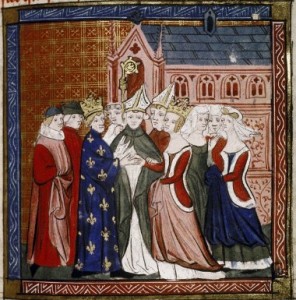 If I had the chance to choose one item to remain after my death, one artefact that would encapsulate my entire life and all its choices and decisions, I seriously doubt that I would choose anything that I either gave or received as a gift at my wedding.
If I had the chance to choose one item to remain after my death, one artefact that would encapsulate my entire life and all its choices and decisions, I seriously doubt that I would choose anything that I either gave or received as a gift at my wedding.
Believe me, nothing from that day would give any future biographers any tremendous insight into my true nature.
But why do physical artefacts matter so much at all? Why is it so important that we know so-and-so touched this, or wore that, or handled this very thing?
I don’t know why it matters, but it does.
Even Eleanor of Aquitaine, one of the most fascinating, powerful, and politically important historical figures a person could name, has only left us with one sparkly vase to remember her by.
And I bet she didn’t even like it all that much.
It was a gift to her first husband, Louis VII; just a rather smallish rock crystal vase that her family prized. And Louis didn’t exactly treasure it for the rest of his natural days. Pious and thickheaded as ever, Louis pretty much turned around and gave it to his pal Abbot Suger, who dedicated the thing, naturellement, to God.
The annoying idea of anyone’s husband regifting a treasured wedding present directly to his closest male friend aside, it just kind of breaks my heart that this is the only actual, physical item that remains of Eleanor — the only thing we can be absolutely sure was handled or owned by her during her long, extraordinary life. Again, I don’t know why this matters. But it does.
We don’t even really know what she looked like.
Maybe this is why I usually deal with more recent history, having settled long ago on the 19th century as my own personal historical stomping grounds. After all, portraits abounded during my chosen time period, and they could even be reasonably relied on to convey not just a person’s physical features but also at least some inkling of their true personality. By the 1840s, you’ve even got the beginnings of portrait photography, and the unbelievable ability to connect across the years by gazing into your subject’s eyes.
It matters. At least, to me it does.
I enjoy Eleanor. I respect the pants off of her. I’ve always been fascinated by her story, her wide travels, her relationship with power at such an interesting and vital point in European (and church) history. But I don’t love her, because I can’t know her. Not really, not viscerally, intuitively. Not like I know my cast of characters from the 19th century, who when I stumble across them by surprise, fill me with a sense of companionable familiarity. Like old college friends I never lost touch with, or at the very least, never stopped thinking of.
I suppose that’s why we history nuts choose our eras, as much as for any other reason. We find out, early on, whose story we can really connect with on a basic, human level. Whose secret thoughts, hidden motives, and galvanizing imperatives we can somehow grok, with an intuitive immediacy that makes their daily struggles, triumphs, faults, and heroisms real to us. Really real. Makes-you-cry-to-think-about-it real.
It’s different for different people. I know plenty of people who can’t get down with the Victorians in the slightest, but who have absolutely no problem whatever hanging out with the Romans, Etruscans, or Greeks. Folks who couldn’t care less about the petty squabbles of early Colonial Americans, but whose hearts thrum in sympathy with the early Christians.
There is, literally, no accounting for taste. And not everyone seems to require the physicality of an artefact, a collection of letters, or a true likeness. What does it matter if a person’s eyes were blue, and brittle with hardship, or dark brown, and limpid with empathy?
Possessions and portraits. They shouldn’t matter to me as much as they do, I guess. But there we are.
Would I be able to have long, late-night cozy chats with Eleanor if she’d left behind an extra brooch, a doodled-in bible, a pair of shoes, a rock solid portrait that brought her vividly to life? Maybe.
Maybe not, though.
In the end, I think our subjects choose us, airy fairy as that might sound. And Eleanor, quite simply, belongs to other folks. That’s fine. She’s got her fans. And I’m extremely glad they’re around to tell her story to the rest of us.
You keep telling your stories. I’ll keep telling mine.
Beth Dunn is a novelist, blogger, and geek. She writes at An Accomplished Young Lady and studies old daguerrotypes and miniature portraits from the 19th century more than most people watch TV.
